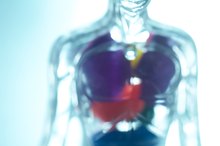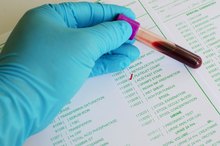Symptoms of Decreased Liver Function
Inflammation, infection or damage caused by toxins or other physical or chemical changes can damage the liver and impair its normal functioning. Because the liver is responsible for so many functions in the human body--including filtering the blood, processing cholesterol, metabolizing toxins and aiding digestion--the effects of decreased liver function may be widespread. If you experience any of these symptoms, contact a health care professional.
If you are experiencing serious medical symptoms, seek emergency treatment immediately.
Jaundice
Jaundice is a condition caused by excessive amounts of bilirubin (a pigmented waste product of old red blood cells) in the bloodstream. The main symptoms of jaundice are an abnormal yellow pigmentation of the skin and whites of the eyes. According to the University of Maryland Medical Center (UMMC), jaundice is often the first and only sign of liver disease 12.
Cholestasis
End-Stage Cirrhosis Symptoms
Learn More
Cholestasis is a condition that occurs when the flow of bile (the digestive fluid produced by the liver) stops because of a blockage inside or outside of the liver.
Abdominal Symptoms
Decreased liver function can cause a number of complications that affect the abdomen. A diseased liver may become enlarged, leading to a generalized sensation of abdominal discomfort or “feeling full.” The liver may also develop vascular problems that affect blood flow, leading to a condition called portal hypertension--high blood pressure in the portal vein that brings in blood from the intestine to the liver. Symptoms of portal hypertension include ascites (accumulation of fluid in the abdomen), gastrointestinal bleeding and black, tarry stools. Portal hypertension may force the liver to develop collateral vessels (varices) to reroute the blood. These varices are often weak and may bleed easily and because the blood is bypassing the liver, it is not being properly filtered.
- Decreased liver function can cause a number of complications that affect the abdomen.
- The liver may also develop vascular problems that affect blood flow, leading to a condition called portal hypertension--high blood pressure in the portal vein that brings in blood from the intestine to the liver.
Liver Encephalopathy Symptoms
Symptoms of Bright's Disease
Learn More
When the liver fails to filter blood normally and remove harmful substances from the bloodstream, toxins can build up and travel to the brain, leading to a condition called liver encephalopathy. This condition can be life-threatening, so seek prompt medical care if any of these symptoms develop.
Liver Failure
Liver failure occurs when a large number of liver cells are damaged and no longer able to function at all. According to the Mayo Clinic, liver failure may come on suddenly, but more commonly occurs after years of progressively decreasing functioning 3. Common symptoms include:
- nausea
- vomiting
- fatigue
- weakness
- loss of appetite
- easy bleeding
- abdominal fullness or tenderness
- brain symptoms like those associated with liver encephalopathy,
- jaundice
Liver failure is a medical emergency, so if you experience any of these symptoms, seek immediate medical care.
Related Articles
References
- University of Maryland Medical Center: Liver Disease Symptoms
- Mayo Clinic: Acute Liver Failure
- Boston Children’s Hospital. Liver failure: symptoms and causes.
- Cincinnati Children's Hospital Medical Center. Acute liver failure. Updated November 2018.
- Kumar S. Overview of Acute Viral Hepatitis. Merck Manual Consumer Version. Updated October 2019.
- Cleveland Clinic. Liver Failure. 2018.
- Stanford Health Care. Chronic Liver Disease.
- Stanford Health Care. Cirrhosis symptoms.
- Kalaitzakis E. Gastrointestinal dysfunction in liver cirrhosis. World J Gastroenterol. 2014;20(40):14686-14695. doi:10.3748/wjg.v20.i40.14686
- El Hadi H, Di Vincenzo A, Vettor R, Rossato M. Cardio-Metabolic Disorders in Non-Alcoholic Fatty Liver Disease. Int J Mol Sci. 2019;20(9):2215. doi:10.3390/ijms20092215
- Tholey D. Liver Failure. Merck Manual Consumer Version. Updated January 2020.
- National Institute on Drug Abuse. Types of Viral Hepatitis.
- Centers for Disease Control and Prevention. Hepatitis D. Updated June 13, 2019.
- Reuben A, Koch DG, Lee WM. Drug-induced acute liver failure: results of a U.S. multicenter, prospective study. Hepatology. 2010;52(6):2065-2076. doi:10.1002/hep.23937
- Cincinnati Children's Hospital Medical Center. Autoimmune Hepatitis.
- MedlinePlus. Fatty Liver Disease. Updated November 19, 2019.
- Johns Hopkins Medicine. Common Characteristics of Liver Disease.
- Stanford Health Care. Liver Function Tests for Chronic Liver Disease.
- National Institute of Diabetes and Digestive and Kidney Diseases. Liver Transplant Surgery. 2017.
- Gustot T, Jalan R. Acute-on-chronic liver failure in patients with alcohol-related liver disease. J Hepatol. 2019;70(2):319-327. doi: 10.1016/j.jhep.2018.12.008.
- Thorsen T, Solheim JM, Labori KJ, Line PD, Aandahl EM. Liver transplantation as a lifesaving procedure for posthepatectomy liver failure and iatrogenic liver injuries. Langenbecks Arch Surg. 2019;404(3):301-308. doi:10.1007/s00423-019-01780-3. Epub 2019 Mar 30.
Writer Bio
Based in New York City, Tricia Mangan began her writing career in 2001. She has co-authored a National Cancer Institute report and a number of research articles that have appeared in medical journals. Tricia holds a Master of Arts in clinical psychology from Stony Brook University and boasts diverse clinical, research and teaching experience.








